An invitation to the in-laws in Idaho to come
see the building turned into a wonderful three-month work party! Floyd
and Bev Worth pitched in like old pros and really made the restoration
possible.
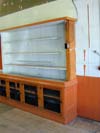 |
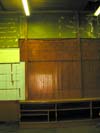 |
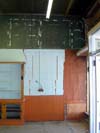 |
The interior of the first showroom was the first
to be tackled. Many display gondolas, yards of shelving on angle brackets
and display panels dropped from the ceiling on chains were removed. Then
four remodelings were peeled away to reveal the original surfaces. "Hardware
Orange" was the unifying color in the True Value store. Light blue had
been applied to some areas not covered in pegboard to lighten the effect
for better merchandise display. Under these paints was milk-paint based
faux-oak grain of the Mathews' remodel of 1905. Under all was solid walnut
with black stained highlights, originally finished in hand rubbed shellac.

|
 |
 |
A band of lightly colored wallboard above the west casework seemed to have been put in during 1905. Over it hung an uninsulated duct which quite dripped with condensation when the air conditioning was in use. The little office area had a roll top desk, a safe and a massive furnace which completely covered the large side window. When all was cleared out, the floor was releveled and a compact horizontal furnace was installed under the window which fed a new duct on top of the west casework, in the position of the old wallboard.
 |
 |
 |
Removing the t-bar dropped ceiling, luaun paneling on the walls above the shelves, and the pegboard removed, we uncovered an amazing amount of 1879 detail. Most striking were the wonderful 9 foot windows and great arched window over the rear door, and the walnut casework showed great promise. The ceiling and walls had not been painted for many years and were darkly colored by the oil stoves which had been used for heating before the Bryant gas furnace was installed perhaps in the sixties.
The mid-seventies alterations to the front of
the building caused the removal of all the original storefront bulkheads,
glass and doors. We found the door posts upstairs in another area being
used as shelf supports! They were only fragmentary, but they gave us exact
locations and dimensions for the new posts, the doors and clerestory window.
Notches in the walls on the east and west showed where the bulkheads had
been and photos from Regina Ehrhardt showed marvelous detail of the front
of the bulkheads and doors.
 |
 |
 |
We looked in vain for the original doors, since
the "throw nothing away" policy had not been strictly adhered to. Phone
and web searches found a cache of doors at Jan's Antiques in Chicago, and
resulted in a pair to fit the 180" high by 69" wide opening. These were
antique doors at antique prices, which was still more desirable than custom
doors at custom prices! Even then Floyd spent days removing the top panels,
repairing and refinishing the refurbished old pocket doors into fully functional
shop doors. The thumb latch was borrowed from the second showroom's alley
doors, and the rim mount massive brass deadbolt from the original back
doors of the 1879 building. Months later, a proper selection of cast iron
steeple hinges was obtained to match the remnants of the hinges found elsewhere
in this part of the building. Six months after all this work, a visitor
surprised us by saying she had the original doors in her basement! We shall
see about bringing them back. Amazing.
 |
 |
 |
 |
 |
Building the bulkheads and framing the windows was a bit of a challenge. The location and detail was getting clearer every time we studied the pictures, but how do you work with cast iron columns that are 3/4" out of plumb when you're trying to fit in insulated glass that comes in rectangles? The quartered panes of this enormous area were originally set into wrought iron t-sections, but we had to have them fabricated from half-oval and flat rolled steel shapes that are available today. This framework wants to be as small as possible to look like the original, so there was not much room to hide the edge seals of the insulated glass, and even less space to adjust for the funny sizes needed to fit wider panels against narrow panels to adjust for the cockeyed opening. It all went together with not an eighth of an inch to spare. The wooden sash along the top, bottom and the brick wall side were made deep enough to take care of the funny sizes, and the center steel mullions and sash against the columns were kept really thin.
Since the seventies store front had been installed
fully forward in the opening with a smaller entry door, it became apparent
that it would not have to be removed while the 1879 style bulkheads, window
framing and windows were installed. So, when the work was structurally
complete with the new windows and doors all closed in, we could take down
the old aluminum storefront, awning, windows and door all at once, revealing
the 1879 style front in place like magic. Some people thought it had always
been there, somewhere underneath!
 |
 |
 |
 |
Starting early in the day, the awning was removed,
then the letters and signage and then the ventilated vertical aluminum
front. Beneath that was a considerable amount of aluminum framing and standoffs.
At last the original brick front was visible. A short time later the lower
window frames and aluminum door were removed and then the exterior trim
was added to the bulkheads.
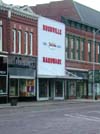 | 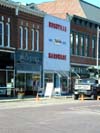 | 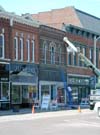 | 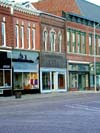 | 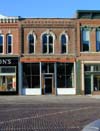 | 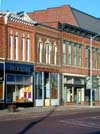 |
Where the orange cornice shows, a layer of fancy trim was replaced, and above, where the adjoining buildings have an upper cornice and peak, the South Side building should have an similar but flat cornice and an arched fancywork sign above the cornice.
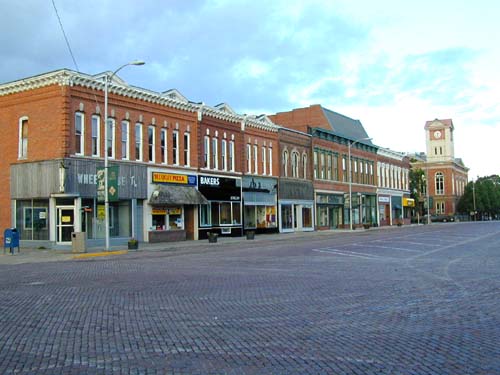
110 W. Lafayette Street, Rushville, Illinois
62681-1417
Now South Side Cafe
Powered by ![]() and copyright 2022 by Karl A. Petersen
and copyright 2022 by Karl A. Petersen